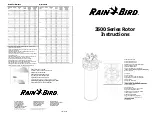
Copyright Safewaze 2023
Page 12
IMPORTANT:
Read and follow manufacturer’s instructions for associated components and subsystems in your personal fall
arrest system.
When using this equipment, employers
must create and maintain a Fall Protection and Rescue Plan and provide the means to implement those plans. The
plans must be communicated to equipment users, authorized persons, and rescuers. These plans must meet ANSI Z359.2 “Minimum Requirements for a
Comprehensive Managed Fall Protection Program.” They should include the requirements and guidelines for the employer’s managed Fall Protection Program.
This would include eliminating and controlling fall hazards, duties and training, policies, fall protection procedures, rescue procedures, incident investigations, and
evaluation of the program’s effectiveness.
During normal operations, the lifeline constituent of the SRL will extend and retract freely with no slack or hesitation as the worker moves at normal speeds. In
the event of a fall, Safewaze SRLs are equipped with a speed sensing braking system. The braking system will activate, stopping the fall, and absorbing much
of the energy created by the fall. Due to the speed sensing braking system, user(s) should avoid quick or sudden movements, as this may cause the SRL to
inadvertently lock. If the user is performing operations near the end of the working length of the SRL, a reserve line is incorporated within the SRL to reduce fall
arrest forces.
Safewaze Fall Protection Equipment is designed for use with Safewaze components and subsystems only. A Qualified Person should make the determination of
Safewaze equipment compatibility with equipment not manufactured by Safewaze. Replacement or substitution of equipment not manufactured by Safewaze,
may degrade, or reduce the safety and reliability of the complete system.
12.0 FALL PROTECTION AND RESCUE PLAN
13.0 NORMAL OPERATIONS
14.0 COMPATIBILITY OF COMPONENTS
FIGURE 5 - UNINTENTIONAL DISENGAGEMENT
Using a connector that is undersized or irregular in shape (1) to connect a snap hook or carabiner could allow the connector to force open the gate of the snap
hook or carabiner. When force is applied, the gate of the hook or carabiner presses against the non-compliant part (2) and forces open the gate (3). This allows the
snap hook or carabiner to disengage (4) from the connection point.
3 - gate opens
2 - gate presses
against
non-complaint
part
4 - parts disengage.
1 - Non-compliant part
NOTE:
SOME SPECIALTY CONNECTORS HAVE ADDITIONAL REQUIREMENTS. CONTACT SAFEWAZE WITH
QUESTIONS.
Connectors are compatible with connecting elements when they have been designed to work together in such a way that their sizes and shapes do not cause their
gate mechanisms to inadvertently open, regardless of how they become oriented. Connectors (hooks, carabiners, and D-rings) must be capable of supporting at
least 5,000 lbs. (2267.9 kg). Connectors must be compatible with the anchorage or other system components (See Figure 5). Do not use equipment that is not
compatible. Non-compatible connectors may unintentionally disengage (See Figure 5). Connectors must be compatible in size, shape, and strength. Self-locking
snap hooks and carabiners are required by ANSI Z359 and OSHA guidelines. Contact Safewaze if you have any questions about compatibility.
15.0 COMPATIBILITY OF CONNECTORS
15.1 MAKING CONNECTIONS
•
In a false engagement, where features that protrude from the snap hook or carabiner catch on the anchor, and without visual confirmation seems to be fully
engaged to the anchor point.
•
To each other.
•
By wrapping the lifeline around an anchor and securing to lifeline except as allowed for Tie-Back models
•
To any object which is shaped or sized in a way that the snap hook or carabiner will not close and lock, or that roll-out could occur.
•
In a manner that does not allow the connector to align properly while under load.
Snap hooks and carabiners used with this equipment must be double locking and/or twist lock. Ensure all connections are compatible in size, shape and strength.
Do not use equipment that is not compatible. Ensure all connectors are fully closed and locked.
Safewaze connectors (snap hooks and carabiners) are designed to be used only as specified in each product’s user’s instructions. (See Figure 6)
for examples of
inappropriate connections. Do not connect snap hooks and carabiners:
•
To a D-ring to which another connector is attached.
•
In a manner that would result in a load on the gate (with the exception of Tie-Back hooks). NOTE: Large snap hooks must not be connected to objects which
will result in a load on the gate if the hook twists or rotates, unless the snap hook complies with ANSI Z359.12 and is equipped with a 3,600 lbs. (1632.9 kg)
gate. Check the marking on your snap hook to verify its compatibility.
NOTE:
Large throat snap hooks must not be connected to standard size D-rings or similar objects which will result in a
load on the gate if the hook or D-ring twists or rotates, unless the snap hook complies with ANSI Z359.12 and is equipped
with a 3,600 lbs. (1632.9 kg) gate. Check the marking on your snap hook to verify that it is appropriate for your application.






































